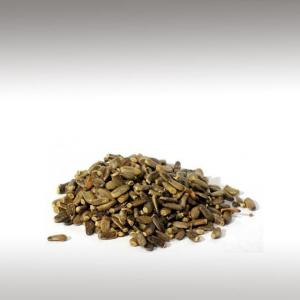
MILK THISTLE OIL (SILYBUM MARIANUM) - BASE OILS

BASE / GENERAL DATA
Information submited: June 2, 2015 Modified: May 9, 2018 By: OperaDreamhouse
Silybum Marianum has other common names include Cardus Marianus, Milk Thistle, Blessed Milk Thistle, Marian Thistle, Mary Thistle, Saint Mary's Thistle, Mediterranean Milk Thistle, Variegated Thistle and Scotch Thistle. This species is an annual or biennial plant of the Asteraceae family.
This fairly typical Thistle has red to purple flowers and shiny pale green leaves with white veins. Originally a native of Southern Europe through to Asia, it is now found throughout the world.
Possibly native near the coast of southeast England, it has been widely introduced outside its natural range, for example into North America, Iran, Australia and New Zealand where it is considered an invasive weed.
Milk Thistle (Silybum Marianum) is a thorny plant presenting decorative leaves with a white pattern of veins and purple flower heads. The plant originates from mountains of the Mediterranean region, where it forms scrub on a rocky base.
It grows 30 to 200 cm tall, having an overall conical shape with an approx.The flower heads are 4 to 12 cm long and wide, of red - purple colour. They flower from June to August in the North or December to February in the Southern Hemisphere ( Summer through Autumn ). The achenes are black, with a simple long white pappus, surrounded by a yellow basal ring.
The seeds of Milk Thistle are one of the most important herbal liver medicines. The sylimarin contained in them is an effective life - saving agent even in cases of poisoning with a lethal dose of death cap mushroom.
Milk Thistles are currently cultivated in large numbers in many countries of the world - for use by the pharmaceutical industry - including: Austria, Poland, Germany, Hungary, China, and Argentina. The plant is typically harvested 2 to 3 weeks after flowering - via a two - step process: cutting and threshing.
Milk Thistle gets its name from the milky sap that comes out of the leaves when they are broken. The leaves also have unique white markings that, according to legend, were the Virgin Mary’s milk.
Don’t confuse Milk Thistle with Blessed Thistle (Cnicus Benedictus).
Chemical structure:
Traditional Milk Thistle extract is made from the seeds, which contain approximately 46% silymarin. The extract consists of about 65 - 80% silymarin (a flavonolignancomplex) and 20 - 35% fatty acids, includinglinoleic acid.
Silymarin is a complex mixture of polyphenolic molecules, including seven closely related flavonolignans (silybin A, silybin B, isosilybin A, isosilybin B, silychristin, isosilychristin, silydianin) and oneflavonoid (taxifolin). Silibinin, a semipurified fraction of silymarin, is primarily a mixture of 2 diastereoisomers, silybin A and silybin B, in a roughly 1: 1 ratio.
This fairly typical Thistle has red to purple flowers and shiny pale green leaves with white veins. Originally a native of Southern Europe through to Asia, it is now found throughout the world.
Possibly native near the coast of southeast England, it has been widely introduced outside its natural range, for example into North America, Iran, Australia and New Zealand where it is considered an invasive weed.
Milk Thistle (Silybum Marianum) is a thorny plant presenting decorative leaves with a white pattern of veins and purple flower heads. The plant originates from mountains of the Mediterranean region, where it forms scrub on a rocky base.
It grows 30 to 200 cm tall, having an overall conical shape with an approx.The flower heads are 4 to 12 cm long and wide, of red - purple colour. They flower from June to August in the North or December to February in the Southern Hemisphere ( Summer through Autumn ). The achenes are black, with a simple long white pappus, surrounded by a yellow basal ring.
The seeds of Milk Thistle are one of the most important herbal liver medicines. The sylimarin contained in them is an effective life - saving agent even in cases of poisoning with a lethal dose of death cap mushroom.
Milk Thistles are currently cultivated in large numbers in many countries of the world - for use by the pharmaceutical industry - including: Austria, Poland, Germany, Hungary, China, and Argentina. The plant is typically harvested 2 to 3 weeks after flowering - via a two - step process: cutting and threshing.
Milk Thistle gets its name from the milky sap that comes out of the leaves when they are broken. The leaves also have unique white markings that, according to legend, were the Virgin Mary’s milk.
Don’t confuse Milk Thistle with Blessed Thistle (Cnicus Benedictus).
Chemical structure:
Traditional Milk Thistle extract is made from the seeds, which contain approximately 46% silymarin. The extract consists of about 65 - 80% silymarin (a flavonolignancomplex) and 20 - 35% fatty acids, includinglinoleic acid.
Silymarin is a complex mixture of polyphenolic molecules, including seven closely related flavonolignans (silybin A, silybin B, isosilybin A, isosilybin B, silychristin, isosilychristin, silydianin) and oneflavonoid (taxifolin). Silibinin, a semipurified fraction of silymarin, is primarily a mixture of 2 diastereoisomers, silybin A and silybin B, in a roughly 1: 1 ratio.

SPIRITUAL PRACTISES DATA

MEDICINE / HEALTH DATA

BEAUTY / COSMETICS DATA

FOOD / COOKING DATA
COMMENTS
No comments.


